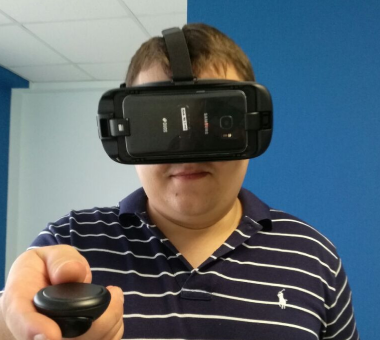Examples of AR/VR in Manufacturing and Industrial Training
Healthcare Training with AR and VR
Virtual Retail and Customer Support Training
According to the Harvard Business Review, traditional employee training often fails to effectively engage learners for three main reasons:
This is where innovative methods such as Augmented and Virtual Reality can be a game-changer. Such technologies make industrial trainings more interactive and less resource consuming. In addition, high competition among VR training software development companies makes these technologies more affordable.
AR and VR training focus on simulating real-world scenarios where employees can directly apply what they have learned to their job roles. This helps bridge the gap between theory and practice, leading to more efficient skill acquisition.
When creating AR/VR training for various fields, such as healthcare, manufacturing, or engineering, our team at HQSoftware witnessed their benefits for companies firsthand. So, we have collected the most relevant real-world AR and VR training examples that demonstrate how these technologies can transform corporate training, making it more engaging and effective.
Examples of AR/VR in Manufacturing and Industrial Training
Healthcare Training with AR and VR
Virtual Retail and Customer Support Training
In the field of manufacturing, examples of Virtual Reality training and industrial AR include immersive simulations for technical staff who are learning tasks such as equipment operation, machinery maintenance, or product assembly.
Employees can master their daily tasks in a virtual environment by practicing unlimited times, gaining hands-on experience without the need for physical equipment. This leads to reduced production errors and fewer accidents in real-world settings. Let’s look at some real-world VR manufacturing training examples.
Ford employs VR in the company’s accelerated credential program to train dealership technicians. With VR maintenance training, technicians can learn about car components in detail without using real ones and then perform diagnostics and maintenance — for instance, how to perform lathe activities.
The 15- to 25-minute simulations are shown on a TV monitor so the supervisor can control the students’ progress and assist them as needed. This kind of Virtual Reality maintenance training lets learners significantly improve their confidence when working on an actual vehicle, while reducing mistakes.
Training among young specialists, particularly when it comes to applying for new jobs, may not always offer sufficient practical experience necessary to effectively perform daily tasks.
At HQSoftware we have developed VR simulations for occupational training that can help overcome this challenge. It enables learners to acquire new skills and mastery in professions such as automotive and aviation mechanics, among others.
With the VR solution, trainers can follow animated instructions and then independently replicate training steps, with voice and visual guidance.
Andrey Kazakevich
Head of Production
at HQSoftwareTo create highly realistic simulations, our team took into account even seemingly insignificant details, such as hand positioning while cutting vegetables. Therefore, students not only gain a general understanding of the subject but also develop accurate hands-on skills.
The VR training resulted in a 84% engagement rate and 67% knowledge retention.
Without sufficient hands-on practice, young doctors can feel extremely insecure when they encounter real clinical situations independently. VR simulation training addresses this issue.
Unlike traditional medical learning, which doesn’t perfectly reflect real-world cases, VR simulations provide interns with experiences that they will encounter in their careers:
Interactive simulations also allow medical professionals to practice critical decision-making and refine their clinical skills simultaneously in a shared, safe environment. This fosters teamwork and remote collaboration among interdisciplinary healthcare teams.
For instance, radiology interns can use Bodyscope to view real-world CT/MRI images in volume in Virtual Reality rather than viewing educational scans in the form of DICOM files. Students can also explore objects together or with supervisors in virtual shared classrooms.
The tool facilitates the development of interns’ awareness and comprehension of various case studies, thereby minimizing errors during real-world practice.
In one survey, a whopping 80% of consumers claimed that just one negative customer experience had led them to switch brands. To avoid such churn and retain your customers, you can simulate real-life customer interactions using VR technology. In this way, your employees can get better at communicating with customers, answering their tricky questions, and even tackling those tough situations that can make or break a customer’s day.
AR and VR training software can gather feedback on employee performance, which can help you identify their strengths and weaknesses to guide their development.
Additionally, AR and VR training sessions are fantastic for hands-on product demonstrations. Employees can virtually showcase product features, highlight benefits, and answer common questions. This helps them become more confident and knowledgeable about the products they are promoting, leading to improved sales and customer satisfaction.
Walmart’s customer service VR training, for instance, offers guidance to staff members on how to handle customer conflicts. This Virtual Reality training example replicates the messy behavior of customers on Black Friday so that employees learn the skills needed to provide exceptional customer service even in difficult circumstances.
In comparison to employees who did not receive VR training, those who did experienced a 10-15% boost in self-confidence and retention.
Want to create an AR/VR solution for your corporate training? We’re ready to help!HQSoftware has a team of skilled professionals ready to tackle the project. Ask me!
Anna Halias
Business Development Manager
AR and VR simulations offer significant benefits in the aviation industry, particularly in aircraft wiring training and pilot training through virtual cockpits.
Here’s how AR and VR simulations can be utilized to create more engaging experiences:
For example, comprehensive VR training for pilots flying short-haul flights was implemented by the Dutch aviation company KLM. The VR training provides 360º video instructions, a virtual cockpit for flying practice, and a virtual walk-around over the aircraft.
Such training allows for repeated practice, reinforces muscle memory, and helps build confidence in dealing with emergencies.
Immersive corporate workshops can go beyond hands-on approaches to exploring job tasks. With interactive workshops, your team can develop the following skills:
How do modern businesses use AR to increase their revenues and outperform their industry competitors?

Overall, Virtual and Augmented Reality in corporate training empowers employees to gain valuable experience and build confidence without real-world harmful consequences. Also, by incorporating AR and VR technologies, you can reduce training time by four times, reducing the need for additional compensation for employees’ non-working hours dedicated to training.
AR, VR, and Mixed Reality training provide interactive experiences that captivate trainees, resulting in higher engagement levels, enhanced problem-solving skills, and improved decision-making.
However, creating highly realistic VR simulations takes a combination of technical expertise, artistic skills, and attention to detail. We at HQSoftware have developed various AR and VR solutions ensuring the desired level of realism and immersion in VR simulations, thanks to close collaboration between developers, graphic designers, and UX/UI specialists.
As a reliable outsourcing provider, we offer a wide range of AR and VR development services to meet all your corporate needs. Additionally, we specialize in creating personalized training scenarios to enhance your learning programs. We thoroughly consider the needs of the project and present options that best satisfy your needs.
Our software engineers can also improve your solution with AI and ML, to provide enhanced features such as natural language processing and real-time data handling.
Get in touch with us to find out more about our AR and VR development services.

AR/VR Expert
A developer with extensive expertise in AR/VR, very ingrained into the topic of Mixed Reality development. Shares his knowledge and the results of many years of work.
We are open to seeing your business needs and determining the best solution. Complete this form, and receive a free personalized proposal from your dedicated manager.

Sergei Vardomatski
Founder